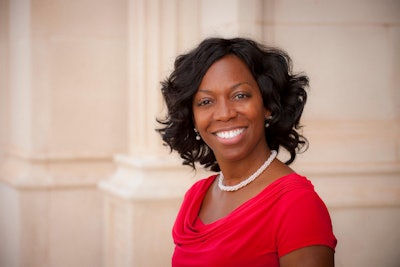What are your responsibilities in your role as vice president of the NCAA Eligibility Center (EC)?
 Felicia Martin
Felicia MartinI am responsible for the EC’s strategic direction and vision. My primary role is to support my people and make certain they have the tools and resources to create pathways of opportunities for young women and men. I lead a dynamic staff that dedicates every day to supporting students’ goals to attend college and fulfill their dreams to compete in college-level athletics. We partner with our membership in the initial eligibility process. We support high school communities that are assisting students as they navigate the transition from high school to university. The EC educates students and parents about the initial eligibility. We update and inform sport associations and grassroots organizations of pertinent updates because they play such vital roles in student-athlete journeys. At the EC, our focus begins and ends with the college-bound student-athlete.
What are the challenges to fostering academic development of student-athletes during the COVID-19 pandemic? What are the short- and long-term implications of those challenges?
The coronavirus pandemic forced sweeping and drastic changes — the challenge of lengthy school closures, canceled standardized testing and the unexpected shift to a full-time remote learning environment. Then, there are the disruptions to nutritional support [and] social and emotional engagement. Data is pointing to students experiencing higher rates of anxiety and depression. Students are grappling with regression and loss of learning. The pandemic illuminated the glaring disparities in access and equity that already existed. The long-term impacts are yet to completely unfold.
How does the pressure of winning impact student-athlete academic success?
For high school students, the pressure to perform is closely aligned to a college scholarship. Yes, recruiting coaches are looking for amazingly athletic women and men who have mastered their sports’ techniques and fundamentals. However, skilled student-athletes without academic achievement jeopardize their chance to earn a college athletic scholarship. College bound student-athletes must meet NCAA initial eligibility requirements. The old slogan holds true — “no pass, no play!” Just as high school students are training to participate on the next level, we encourage them to work even harder in the classroom.
How does diversity come into play in your role?
There are around 8 million high school student-athletes. Out of the 8 million, each year the EC certifies more than 100,000 student-athletes including about 7,000 international students. Diversity is extremely important to the work we do in the NCAA Eligibility Center. Each college bound student-athlete has her/his own ethnic, racial identity and socioeconomic level. They bring their cultural background and diverse family structure to our process and transition to colleges and universities. We recognize and embrace all students as we educate, advise and encourage.
What dish does your family ask you to make for holiday meals?
I am the family mixologist. From mocktails to cocktails, I have a recipe for every occasion.
Did you play any sports in high school, college or professionally?
I was not blessed to be an athlete. My gift is to lift, cheer and encourage all the talented athletes around me.
What was your favorite television program or movie from your childhood and what did you like about it?
During my childhood, we had wonderful television shows. It is difficult to pick just one from Good Times, Sanford and Son, and The Jeffersons. My favorite childhood movie was The Wiz! It was the drama, music and dancing that pulled me in.
What can or does the NCAA do to support the non-Power 5 conferences and those in Division II and III that lack the financial resources of the major programs when it comes to academic support for student-athletes?
Approximately 90% of NCAA revenue are direct distributions to the member schools or for services that benefit student-athletes. Funds are distributed to DII and DIII member schools to support student-athletes, grants, promote leadership programs and student-athlete well-being, enhance academic opportunities and provide help to student-athletes with essential financial needs.
What is your favorite guilty pleasure?
Sophia, Blanche, Rose and Dorothy — I love watching the re-runs of The Golden Girls. I giggle at each joke and laugh at punch lines as if I’ve never heard them.
Last year you gave a great motivational talk to the 2020 Arthur Ashe Award winners. Do you have any advice for this year’s honorees?
Nothing in life is 100% perfect all of the time. We should expect a stormy, rainy circumstance every once in a while. The key isn’t to wait until the rain stops. Grab your umbrella and put on your rain boots. We must learn to dance in the rain. The sunshine isn’t the only forecast where we can find joy.
This article originally appeared in the April 29, 2021 edition of Diverse. Read it here.





















